Rhys Hoskins first made serious waves around the baseball world in mid-2016 when he smacked 38 homers in AA for the Reading Fightin’ Phils. He then followed that up by bashing 29 home runs through a mere 115 games in AAA in 2017. He was the rare prospect who showed elite power while maintaining a reasonable strikeout rate—a combination that tends to work well at the MLB level.
And did it ever work upon his major league call-up. He smacked 18 long bombs through his first 34 games, becoming the fastest player in major league history to hit 10, 11, 12, 13, 14, 15, 16, 17 and 18 home runs along the way. Although Hoskins’ historic pace eventually abated, he has become a reliable source of power and on-base skills in his now nearly two-year big league tenure, with a career batting line that rests at an impressive .255 / .371 / .523.
However, pitchers are beginning to adapt to an approach predicated on deriving offensive value from pulled fly balls. The result is that Hoskins’ whiff and strikeout rates are creeping up while his rates of hard contact are decreasing.
Although his box score figures in 2019 look great, headlined by a .909 OPS (note that this and all subsequent stats in the article are as of Friday, June 14th), Hoskins’ xStats are quite unimpressive, with an xSLG that resides in the neighborhood of that of Tim Beckham, Niko Goodrum, and Christian Vazquez.
It’s likely that a stiff wave of regression is about to hit Hoskins as his actual production begins to converge to expected levels. While his offensive baseline will stay above average, he is not the top-30 fantasy asset that many rankings paint him out to be. Fantasy owners with shares in Hoskins should look to deal him while his value is still high.
Concerning Trends
Hoskins went on the IL in late May 2018 after fouling a ball off his face. At this juncture, Hoskins had accrued 428 career PA and, after a slump to start off the 2018 season, owned a career .514 SLG. This tracked closely to the .511 xSLG he produced over the same span.
In the 737 PA Hoskins has accrued since returning from injury, he’s produced similar traditional numbers, highlighted by a .527 SLG. But his xSLG has fallen off a cliff, dropping to .447 over the same period. In fact, Hoskins’ 85-point SLG overperformance since June 2018 is the fifth-highest in baseball and the second-highest excluding players who play their home games in either Coors or Chase Field.
xSLG is one of the several xStats on Baseball Savant that predicts a player’s statistical performance based on the underlying quality of their batted balls. The ever-widening gulf between Hoskins’ xSLG and SLG should be of concern to Phillies fans and Hoskins fantasy owners, as it indicates that he’s benefiting from a disproportionate amount of good luck.
Some of that good fortune is coming from fortunate bounces on batted balls, as Hoskins’ 2019 xBA of .234 trails his actual average of .273 by nearly 40 points. The main culprit here is a .325 BABIP—an unsustainable level for a player that hits as many fly balls and pop-ups as Hoskins. Consider that Hoskins’ BABIP was .241 in 2017 and .272 in 2018.
The other area of good luck for Hoskins is his performance on extra-base hits. Hoskins xISO in 2019 rests at .182 compared to his actual ISO of .244. While Hoskins’ pull inclinations mean that he will usually outperform his xISO, a 60 point overperformance will be difficult to sustain. Hoskins’ average home run distance in 2019 is the second-lowest of the 103 players who have hit at least 10 home runs. It’s likely that some of the home runs Hoskins has hit so far this season will turn into doubles or fly outs as the season progresses.
Hoskins’ severe xSLG deterioration indicates he is hitting significantly fewer well-hit balls. In particular, Hoskins’ barrel rate has declined from 13.5% in 2017 to 9.8% in 2019. Meanwhile, his rate of pop-ups has more than doubled from 6.3% to 13.2%. Hoskins’ 13.4% pop-up rate since June 2018 rates as the fifth highest in baseball among 176 hitters with at least 300 batted balls in that span.
Another issue is that Hoskins’ contact ability has been incrementally getting worse since his MLB debut. His strikeout rate is up to 23.8% in 2018 while his whiff rate has climbed to 23.5%. While these are certainly reasonable levels on an absolute basis, it’s concerning that he’s whiffing more while his batted ball metrics are getting worse. As I discussed in a previous article, it’s normal for whiff rate to increase when a player gears their swing to hit more barrels. But the fact that Hoskins’ whiff rate is increasing while his quality of contact is deteriorating is a warning signal.
Establishing Context
Hoskins’ increased inclination for weak contact and whiffs has resulted in his xSLG falling to a morbid .417 in 2019—a level that ranks in the 43rd percentile of MLB hitters with at least 150 PA on the year. A player regarded as one of the best power hitters in baseball should not be sharing page space with Christian Vazquez on the xSLG leaderboard.
Note that Hoskins’ +.100 SLG-xSLG differential is by far the highest of the group and will be difficult to sustain. From 2016 to 2018, no hitters achieved a 100 point SLG-xSLG overperformance and only 11 hitters crossed 50 points. Five of those players played their home games in the run-inflating environment of Coors Field, while another, Billy Hamilton, used his elite speed to beat out his expected production.
Didi Gregorius, Zack Cozart, Scooter Gennett, Jose Ramirez, and Jonathan Schoop are the other names populating the 11 SLG overperformers. Each of these players, along with Hoskins, possesses an inclination for pulled fly-balls and thus is likely to overperform their xSLG.
Yet none of these case studies presents a particularly positive example. Cozart has been arguably baseball’s worst hitter over the last 18 months, while Ramirez owns a meager .339 SLG since August 1st of last season. Schoop has proven to be incredibly inconsistent and was non-tendered by the Brewers heading into 2019. Gregorius and Gennett are perhaps the best examples of players that have achieved long-term success by outperforming their xStats, however, they both operate at a level significantly below what fantasy owners would expect from Hoskins.
Unless Hoskins can find a way to fix his worsened contact and batted ball issues, it’s very likely that he will enter a rough patch where his box score statistics converge closer to his xStats.
Hoskins as a Hitter
Hoskins is striking out and whiffing more while exhibiting deteriorating batted ball authority. Before diving into what’s behind these developments, we need to understand his overall approach.
Hoskins is very likely a guess hitter. He goes up to the plate with a plan of attack, mainly aimed at driving a fastball over the plate to the pull side, and doesn’t possess much other diversity in his approach.
Hoskins absolutely destroys fastballs, with the 14th highest xwOBA on the pitch since his debut in August 2017. Meanwhile, his xwOBA on breaking balls resides at a lowly .265, registering in the 25th percentile of hitters at large and well below his fastball-feasting colleagues above. It seems like he comes to plate looking for a fastball and thus can’t do much when he receives a breaking pitch.
The other aspect of his approach that suggests he’s a guess hitter is a 26.8% pull rate on flies and liners, which ranks second in baseball. To pull balls in the air at that much likely means that Hoskins is going to the plate with that singular objective in mind. While pulled airballs are a great result, to gear your approach to hit them in excess indicates an underlying fragility that isn’t equipped to take what the pitcher gives in an at-bat.
Once again, Hoskins finds himself on a leaderboard with some uninspiring names. The sputtering outputs of Ramirez and Matt Carpenter are great examples of how pitchers can adjust to neutralize hitters that prioritize pulled airballs. Moreover, Suzuki, Curtis Granderson, Evan Gattis, and Matt Adams are all average to below-average hitters.
The cases of Joey Gallo, Edwin Encarnacion, and Hunter Renfroe present some hope for Hoskins’ approach in the long run, but each comes with caveats. Gallo has actually reduced his pull rate in 2019 and also hits the ball significantly harder than Hoskins. Encarnacion is a better all-around hitter, doing more damage on breaking balls and offspeed offerings. Renfroe is actually a great comp for Hoskins right now, but is also likely due for some significant regression as well.
A strategy predicated on hitting fastballs to the pull side makes Hoskins a fragile hitter. Pitchers with plus fastball command or breaking ball ability have a decent shot at neutralizing him.
Pitcher Adaptations
When Hoskins debuted in late 2017 he was a relatively unknown quantity at the MLB level. A hulking righty hitter with pull inclinations, pitchers grooved the ball right into his wheelhouse over his first roughly 35 days in the majors.
From August 10th through September 14th 2017, Hoskins saw 58.5% fastballs and they were primarily located over the inner heart of the plate. He proceeded to set numerous MLB home run records that are unlikely to be broken in the near future.
But from September 15th onward Hoskins struggled, continuing through the start of 2018. Pitchers adapted by moving their fastball locations from the inner to the outer half of the plate. Hoskins still did well on fastballs in aggregate, but he didn’t dominate them as furiously as he did in the month after his call up.
The other, more substantial, adjustment that pitchers made was to throw him more breaking balls, with usage rates increasing from 27% around his debut to nearly 32% over the last year.
As they learned that Hoskins was inclined to chase breaking pitches down and away, pitchers also started placing them further outside of the strike zone, which has given Hoskins fits. His whiff rate on breakers has climbed all the way up to 43% in 2019.
The improved plan of attack against Hoskins is the probable culprit behind his diminished xStat performance. With pitchers gearing the ball to the outer half of the plate, Hoskins has fewer opportunities to sit on pitches he can drive on in the inner half.
It’s evident from the charts above that Hoskins’ happy zones are located middle-in and low-middle-in. His average exit velocity drops precipitously on the outer-middle and lower half of the plate—the exact zone that pitchers have started attacking more frequently with both fastballs and breaking balls.
Conclusions
Hoskins, despite his flaws, is still a good hitter. His mid-teens walk rate and reasonable strikeout rate, combined with his love of pulled fly balls, will ensure he maintains an above-average offensive baseline.
But consensus rankings have Hoskins as a top 30-fantasy player, ahead of names like Juan Soto and Bryce Harper. That level is simply too high for a player whose xStats paint the picture of a league-average power hitter. Those same rankings place Matt Carpenter, a hitter with a very similar underlying profile as Hoskins, at 142. I believe that Hoskins, while a good hitter, is more akin to Carpenter than Soto or Harper.
Hoskins is riding a wave of fortunate luck thus far in 2019. His owners in re-draft leagues should look to deal him while his value is still high. Meanwhile, those in keeper leagues should contemplate whether someone with such a one-dimensional offensive profile is worth sticking with long-term.
Featured Image by Justin Paradis (@freshmeatcomm on Twitter)

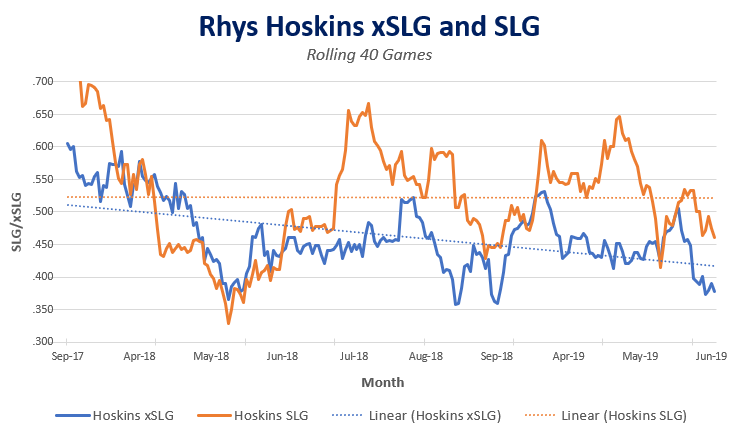
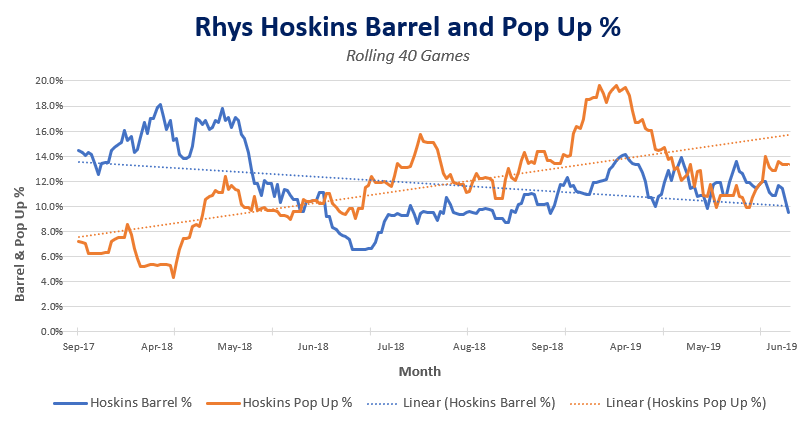
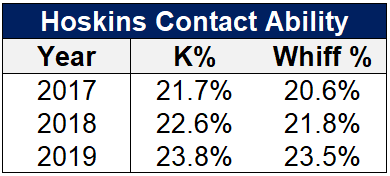
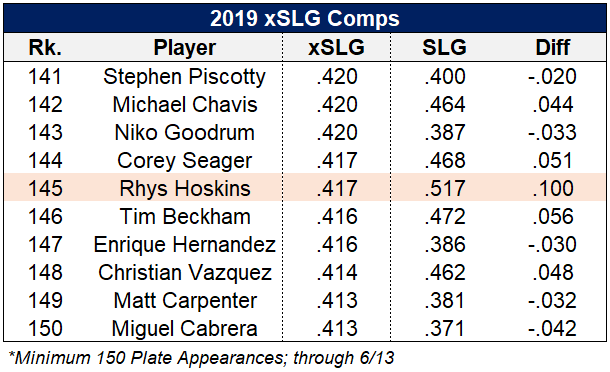




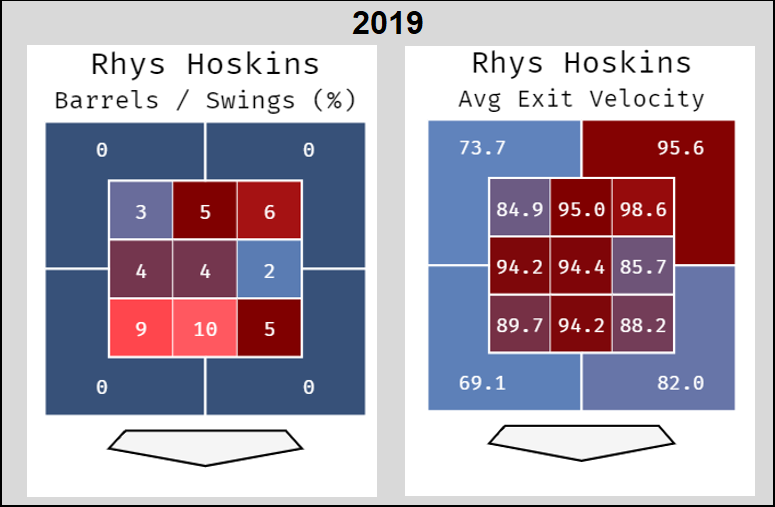
Question about trading Hoskins. Would you trade Hoskins in a 10-team redraft league, 6×6 roto H2H setup for Nelson Cruz?
We can keep 10 players each year, and I have Hoskins in the first round and am not planning on keeping him. Would you make that trade?
Yes – especially if the league uses AVG.
Cruz is posting some of the best contact metrics of his career this year. I like him in the second half more than Rhys.